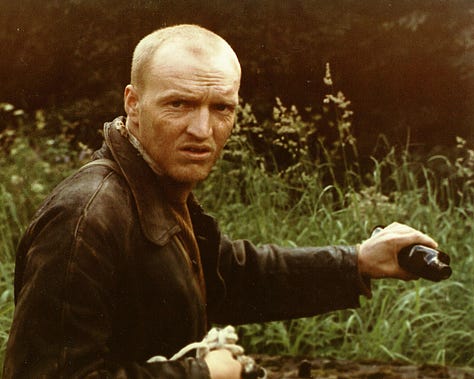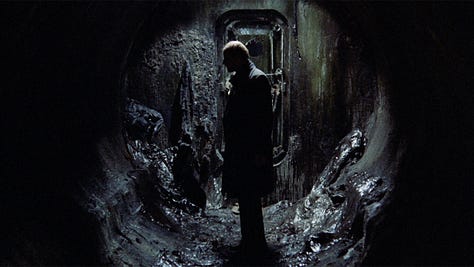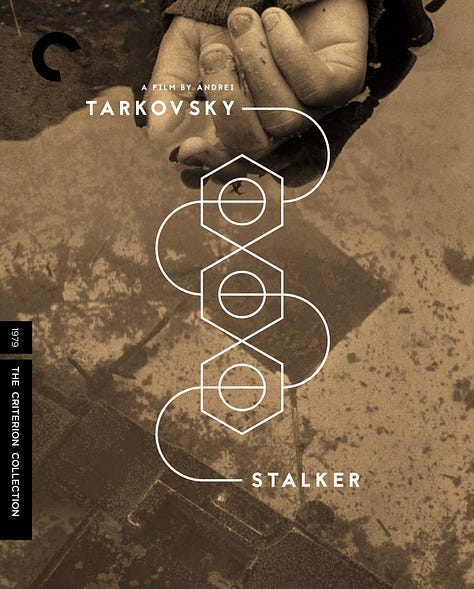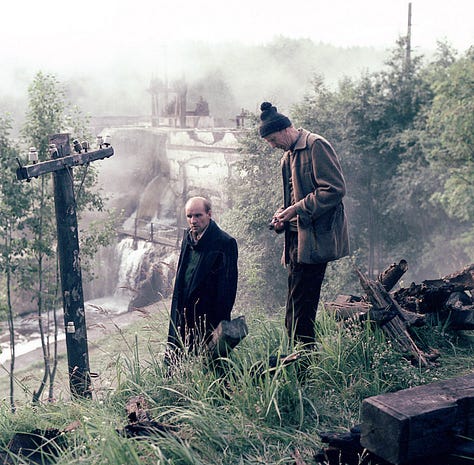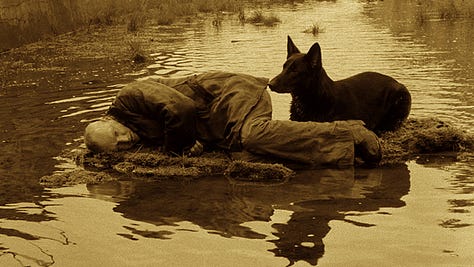STALKER
1979 • Andrei TarkovskyCast: Alexander Kaidanovsky, Anatoly Solonitsyn, Alisa Freindlich, Nikolai Grinko
Screenplay: Arkady Strugatsky, Boris Strugatsky; Based on Roadside Picnic 1972 novel by Arkady Strugatsky, Boris Strugatsky
Cinematography: Alexander Knyazhinsky
Music: Eduard Artemyev
Goskino
The Zone wants to be respected. Otherwise, it will punish.
Next to a dark, miserable unnamed city lies "The Zone," a forbidden area protected by barbed wire. A man known as a stalker, a mentally gifted guide, takes a job leading two men through the Zone to get to the mysterious Room, which can supposedly grant one's wishes. They cannot take a straight path to the Room, and the path is dangerous as the laws of reality no longer apply in the Zone. When they finally reach their destination, they must wrestle with the idea of whether The Room will grant their conscious wish or their true, unconscious desire. A difficult film to comprehend at first, but much like Tarkovsky's work, it rewards multiple viewings.
Stalker is not necessarily a straightforward narrative, at least not on the first watch. It is an ambiguous film that is akin to a visual poem. (Which makes sense as Tarkovsky’s father was a poet). It has been interpreted as an enigmatic allegory for religion, faith, philosophy, and even the Soviet Union itself. It challenges viewers to question reality and explore the depths of the human psyche. Through its haunting imagery and cryptic dialogue, the film invites interpretation and contemplation. As the narrative unfolds, we are transported into a world of uncertainty and ambiguity.
The visual aesthetic of Stalker is distinctive, characterized by a kind of washed-out yellow look that permeates the film's opening scenes. This color palette sets a tone of desolation and melancholy, establishing an atmosphere of existential uncertainty from the outset.
Andrei Tarkovsky's meticulous approach to framing, composition, and camera movement imbues every scene with a sense of purpose and intentionality. The (extremely) slow zooms and pans employed throughout the film serve to draw viewers into the world of the Zone, allowing them to linger on the desolate landscapes and crumbling architecture that populate the characters' journey. Rather than rushing through scenes, Tarkovsky's deliberate pacing encourages contemplation and reflection, inviting viewers to immerse themselves fully in the film. One of the most striking aspects of the cinematography is how the camera seems to move with a sense of purpose. Each shot is carefully composed, with every frame revealing new layers of meaning. Through slow, deliberate movements, the camera becomes a window into the souls of the characters, but it is up to the audience to interpret their innermost thoughts and desires.
By employing long takes, Tarkovsky allows scenes to unfold organically without interruption. This technique fully immerses the audience in the world of the film, fostering a deep emotional connection with the characters and their journey. The long takes serve a dual purpose: they not only emphasize the desolation of the characters' surroundings but also invite contemplation and introspection. As viewers accompany the characters on their journey through the Zone, they are afforded the time and space to reflect on the existential themes that underpin the narrative. Additionally, the extended duration of the takes underscores the characters' sense of vulnerability and uncertainty as they navigate the dangers of the Zone. With each passing moment, the desolation and despair become palpable. By immersing us in uninterrupted sequences of contemplative reflection and existential exploration, we confront the profound mysteries of the human condition.
Stalker predominantly relies on diegetic sound. Throughout the film, the diegetic sounds feel amplified, creating a sense of heightened sensory perception that intensifies one's engagement with the character’s surroundings. Every footstep, rustle of leaves, and drip of water resonates with clarity, drawing you deeper into the Zone. Tarkovsky creates a stark and unsettling soundscape that underscores the isolation of The Zone. The absence of a traditional musical score allows the ambient sounds of the environment to take center stage, enveloping audiences in a visceral auditory experience. However, the sparing use of non-diegetic music, particularly in the final scene involving the Stalker's daughter, serves as a transformative moment within the narrative. As Beethoven's "Ode to Joy" plays in the background, we are confronted with a revelation (which I will not spoil), that may (or may not) answer the true nature of the Zone. This juxtaposition of diegetic sound and classical music underscores the film's thematic exploration of reality and illusion, inviting you to question the nature of truth and perception.
The sudden transition to color upon entering The Zone is a pivotal moment that may evoke comparisons to the iconic transition in The Wizard of Oz. In the classic 1939 film, Dorothy steps out of the sepia-toned monochrome of the real world and enters the technicolor fantasy of Oz. While Stalker isn’t nearly as whimsical, this shift from a drab and desaturated world to one filled with color serves as a visual metaphor for the journey into the unknown. It symbolizes a departure from the mundane reality of everyday life into a realm of possibility and imagination. The Zone becomes a sanctuary where dreams can be realized and desires fulfilled, contrasting sharply with the bleakness of the outside world.
The Zone is ugly, trashed, polluted, and yet astonishingly beautiful. A paradoxical landscape. On the surface, the Zone appears ravaged by neglect and pollution, its landscape scarred by the remnants of industrialization and human (or extra-terrestrial) exploitation. The crumbling buildings and rusted machinery reflect the bleakness of the surroundings and the existential despair that permeates the narrative. However, amidst the desolation, there exists a haunting beauty that captivates the imagination and defies conventional notions of aesthetics. The overgrown vegetation and decaying structures hint at the resilience of nature and the inexorable passage of time. The beauty of the Zone lies in its ability to evoke a sense of wonder and awe in those who dare to explore its depths. It is a place of paradox and contradiction, where ugliness and beauty coexist in harmony.
The question of whether it is better to believe in something or accept reality lies at the heart of Stalker and is reflected in the characters’s motivations and actions. As they venture deeper into the Zone, they are forced to confront their innermost desires and beliefs, grappling with the existential dilemma of truth versus illusion. The Writer, the Professor, and the Stalker serve as archetypes, each pursuing their own understanding of the enigmatic Zone and its mysteries. For the character of The Writer the allure of the Zone lies in its promise of fulfillment and escape from the harsh realities of their lives. He is willing to abandon rationality and embrace the unknown in pursuit of their deepest desires, regardless of the consequences. Conversely, the Professor embodies the scientific method, approaching the Zone with a rational and empirical mindset. The Professor's skepticism and insistence on rational inquiry serve as a foil to the other characters' more intuitive approaches. The Stalker represents faith and intuition. He possesses a deep-seated belief in the transformative power of the Zone, guided by an instinctual understanding of its mysteries rather than a rational comprehension. Unlike the other characters, the Stalker does not seek to understand how the Zone works; instead, he embraces its inherent ambiguity and allows himself to be guided by faith and intuition.
The film delves deeply into the theme of innermost desires, prompting viewers to question the nature of their own aspirations and the potential consequences of their fulfillment. Throughout the film, the characters confront the possibility that their innermost wishes may not bring the fulfillment they seek but rather lead to unforeseen regrets and disillusionment. As they venture deeper into the Zone, they are forced to confront their deepest fears and desires, grappling with the realization that what they thought they wanted may not align with their truest selves.
The influence of Stalker extends far beyond its initial release, inspiring filmmakers and audiences alike with its profound insights and haunting imagery. Films like Annihilation (2018) and Interstellar (2014) draw upon similar themes of exploration, transformation, and existential inquiry, echoing the surreal and enigmatic atmosphere of Tarkovsky's masterpiece. Tragically, the filming of Stalker took a toll on Andrei Tarkovsky and his crew, with many experiencing health issues due to prolonged exposure to toxic environments. Tarkovsky's untimely death serves as a poignant reminder of the sacrifices made in the pursuit of artistic vision.
There's no going back. Nobody goes back the same way they came.
Notable Awards & Accomplishments
Cannes Film Festival: Prize of the Ecumenical Jury
Cahiers du Cinéma: Top 10 Film Nominee - Best Film
Streaming: Criterion, MAX
Digital Rental/Purchase: Available at major retailers
Physical Media: Available on Blu-Ray and DVD
